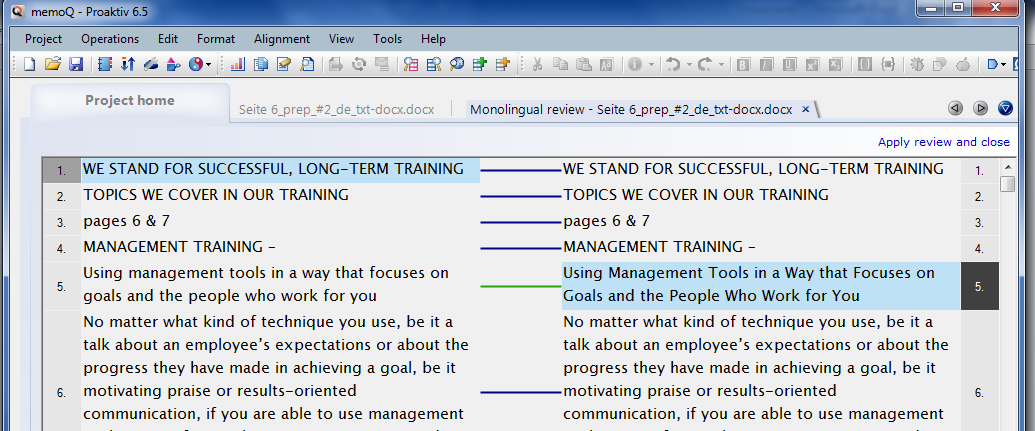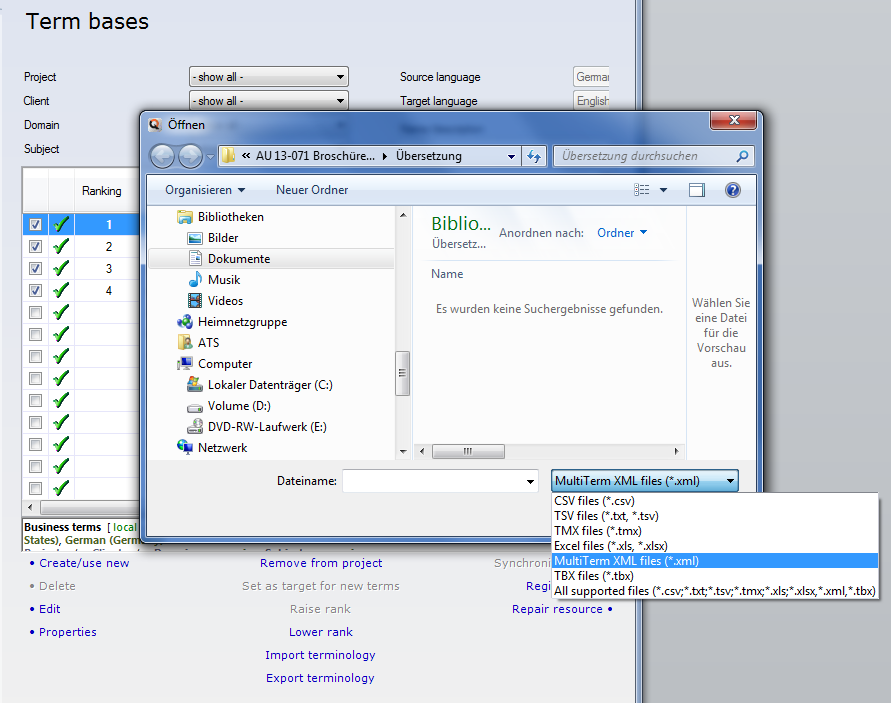 MemoQ (pronounced "memo kyu") is a CAT tool that has become very popular among translators, partly because it offers a lot of convenient features and is relatively easy to use; beginners can learn how to set up a project and translate and export texts with the tool in just 1-2 hours. Plus it can process a wide range of file formats smoothly, including Trados 2007's bilingual RTF and SDL Trados Studio 2009/2011 files in XLIFF format. Last but not least, I personally think it's good value for money, especially if you buy it as part of a promotion or group purchase!
MemoQ (pronounced "memo kyu") is a CAT tool that has become very popular among translators, partly because it offers a lot of convenient features and is relatively easy to use; beginners can learn how to set up a project and translate and export texts with the tool in just 1-2 hours. Plus it can process a wide range of file formats smoothly, including Trados 2007's bilingual RTF and SDL Trados Studio 2009/2011 files in XLIFF format. Last but not least, I personally think it's good value for money, especially if you buy it as part of a promotion or group purchase!
A new version of memoQ called memoQ 2013 was released at the end of May and includes lots of enhancements and several new features, including an integrated online dictionary search facility that you can configure yourself using as many of your favourite Web resources as you like. (This is in addition to the Eurotermbank plug-in that memoQ comes with.)
Release 2 of memoQ 2013 is now just about to be launched, and this promises to be a great leap forward in terms of user convenience. For one thing, it has a feature called monolingual review that translators will love! It saves you a great deal of time updating translation memories (TM) when a customer or reviewer sends you the final version of a translation you've done. In most CAT tools, updating a TM to include the latest changes is a laborious manual process, but memoQ 2013 R2 has automated the step for Word® and other documents, employing a re-alignment procedure to update the segments stored in your TM.

Fig. 1: When you import the final version, memoQ opens an alignment window. The green lines mark the segments that have been changed.
Another enhancement is the ability to import term bases straight from SDL's terminology tool MultiTerm®. This is useful if a customer sends you a document to translate using specific terms they work with and have stored in that format. More specifically, memoQ 2013 now enables you to import MultiTerm XML or TBX files, extract the terms and include them in a term base of its own, which you select yourself. This gives you faster leverage of the customer's resources.

Fig. 2: To import a MultiTerm XML file (term base), click on "Import terminology" and then select the format.
There are a number of other improvements as well, some of which concern the DOCX filter for importing and exporting Word® documents. Exporting comments made in memoQ along with a translation has now been implemented. (This has been possible in other CAT tools such as Déjà Vu X and X2 for ages, but not in memoQ, and saves you a lot of time inserting comments into your translation manually after exporting it.)
But to find out more about it, why not attend Kilgray's introductory webinar on the new release? It's going to be held from 5-6 pm CET (4-5 pm GMT) on Monday 28 October. It's free – all you have to do is register in advance. Click here to go to the registration page.
Have fun trying out the program! (You'll be able to download it shortly and can try it out for free for 45 days.)
Best,
Carl
memoQ logo: courtesy of Kilgray Translation Technologies; screen shots: my own.
P.S. (written on 13 Nov. 2013) A free recording of the webinar is now available on the internet – click here to access it.

 Well, the build-up to its appearance on the translation stage was big, as you might expect from SDL Trados! Have you heard the news yet? If you're also a translator and use translation software to help you with your daily work, then you may already be aware that the largest maker of computer-assisted translation (CAT) software tools recently launched the latest version of its key product (on 30 September).
Well, the build-up to its appearance on the translation stage was big, as you might expect from SDL Trados! Have you heard the news yet? If you're also a translator and use translation software to help you with your daily work, then you may already be aware that the largest maker of computer-assisted translation (CAT) software tools recently launched the latest version of its key product (on 30 September). Studio 2014 is based on the 2011 version, but the interface has been enhanced to make it easier to use. One of the main changes you'll notice is that a ribbon-based interface has now been adopted, organising related functions in tabs in a similar way to the programs that come with Microsoft Office 2007/2010. So if you're used to working with the latter, you ought to find it relatively easy to get to grips with Studio 2014. In addition to that, new areas have been added to the interface for training purposes – you can now access training videos directly from the program, for example – and you can access additional "apps" for Studio from here, too, by following an internal link to SDL's
Studio 2014 is based on the 2011 version, but the interface has been enhanced to make it easier to use. One of the main changes you'll notice is that a ribbon-based interface has now been adopted, organising related functions in tabs in a similar way to the programs that come with Microsoft Office 2007/2010. So if you're used to working with the latter, you ought to find it relatively easy to get to grips with Studio 2014. In addition to that, new areas have been added to the interface for training purposes – you can now access training videos directly from the program, for example – and you can access additional "apps" for Studio from here, too, by following an internal link to SDL's 
 For a while now, I've been receiving some rather odd applications for freelance work by e-mail. This prompted me to write a post about the do's and don'ts of
For a while now, I've been receiving some rather odd applications for freelance work by e-mail. This prompted me to write a post about the do's and don'ts of  Well, having been a member of a German association for translators and interpreters for a number of years now, I'd say it can definitely help a professionally minded translator in several ways. It's an opportunity to
Well, having been a member of a German association for translators and interpreters for a number of years now, I'd say it can definitely help a professionally minded translator in several ways. It's an opportunity to
 This is just a brief reminder that there's a free webinar on Kilgray's new Language Terminal today (see my earlier post on the user platform
This is just a brief reminder that there's a free webinar on Kilgray's new Language Terminal today (see my earlier post on the user platform  Those of you who are already familiar with SDL's OpenExchange platform will see that Kilgray's platform is only similar in terms of its "light resource marketplace". Even then, it's actual users who mainly upload light resources to share with other memoQ users, while
Those of you who are already familiar with SDL's OpenExchange platform will see that Kilgray's platform is only similar in terms of its "light resource marketplace". Even then, it's actual users who mainly upload light resources to share with other memoQ users, while  The good thing about e-learning is that it is generally done at your own pace rather than the speed set by a teacher, it's done at a time of day and a location that you can generally choose yourself, and in some cases, you can even tackle the subjects that are covered in the order that suits you best. So it's a very flexible form of instruction, which helps to make it effective.
The good thing about e-learning is that it is generally done at your own pace rather than the speed set by a teacher, it's done at a time of day and a location that you can generally choose yourself, and in some cases, you can even tackle the subjects that are covered in the order that suits you best. So it's a very flexible form of instruction, which helps to make it effective. summary at the end of each one in the form of short questions with three possible answers. The style of them is like a webinar in which the tutor talks as you watch their presentation (some user interaction would make the lessons more dynamic in my opinion, even if it's just physically ticking the right answers to questions).
summary at the end of each one in the form of short questions with three possible answers. The style of them is like a webinar in which the tutor talks as you watch their presentation (some user interaction would make the lessons more dynamic in my opinion, even if it's just physically ticking the right answers to questions).


Comments